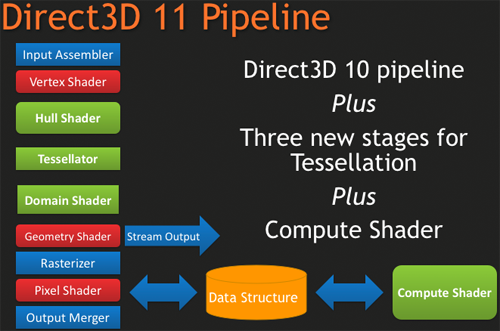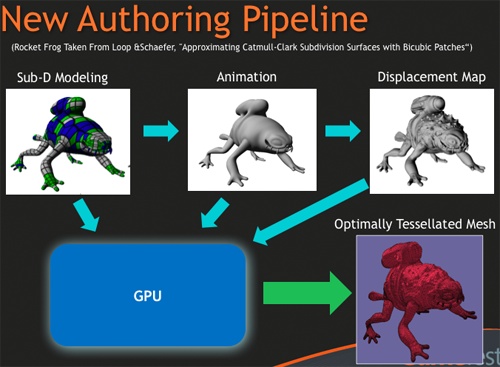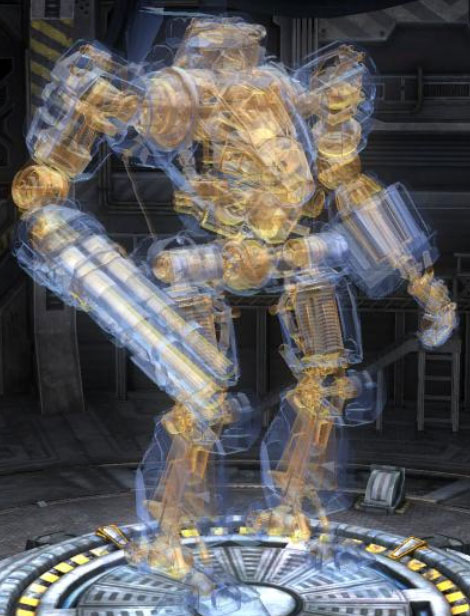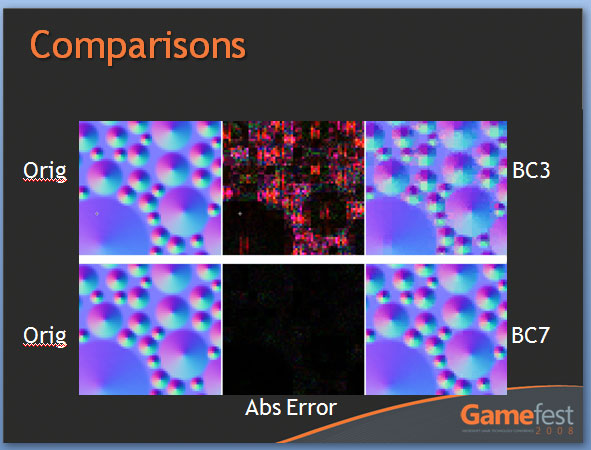AMD's Radeon HD 5870: Bringing About the Next Generation Of GPUs
by Ryan Smith on September 23, 2009 9:00 AM EST- Posted in
- GPUs
DirectX11 Redux
With the launch of the 5800 series, AMD is quite proud of the position they’re in. They have a DX11 card launching a month before DX11 is dropped on to consumers in the form of Win7, and the slower timing of NVIDIA means that AMD has had silicon ready far sooner. This puts AMD in the position of Cypress being the de facto hardware implementation of DX11, a situation that is helpful for the company in the long term as game development will need to begin on solely their hardware (and programmed against AMD’s advantages and quirks) until such a time that NVIDIA’s hardware is ready. This is not a position that AMD has enjoyed since 2002 with the Radeon 9700 and DirectX 9.0, as DirectX 10 was anchored by NVIDIA due in large part to AMD’s late hardware.
As we have already covered DirectX 11 in-depth with our first look at the standard nearly a year ago, this is going to be a recap of what DX11 is bringing to the table. If you’d like to get the entire inside story, please see our in-depth DirectX 11 article.
DirectX 11, as we have previously mentioned, is a pure superset of DirectX 10. Rather than being the massive overhaul of DirectX that DX10 was compared to DX9, DX11 builds off of DX10 without throwing away the old ways. The result of this is easy to see in the hardware of the 5870, where as features were added to the Direct3D pipeline, they were added to the RV770 pipeline in its transformation into Cypress.

New to the Direct3D pipeline for DirectX 11 is the tessellation system, which is divided up into 3 parts, and the Computer Shader. Starting at the very top of the tessellation stack, we have the Hull Shader. The Hull Shader is responsible for taking in patches and control points (tessellation directions), to prepare a piece of geometry to be tessellated.
Next up is the tesselator proper, which is a rather significant piece of fixed function hardware. The tesselator’s sole job is to take geometry and to break it up into more complex portions, in effect creating additional geometric detail from where there was none. As setting up geometry at the start of the graphics pipeline is comparatively expensive, this is a very cool hack to get more geometric detail out of an object without the need to fully deal with what amounts to “eye candy” polygons.
As the tesselator is not programmable, it simply tessellates whatever it is fed. This is what makes the Hull Shader so important, as it’s serves as the programmable input side of the tesselator.
Once the tesselator is done, it hands its work off to the Domain Shader, along with the Hull Shader handing off its original inputs to the Domain Shader too. The Domain Shader is responsible for any further manipulations of the tessellated data that need to be made such as applying displacement maps, before passing it along to other parts of the GPU.

The tesselator is very much AMD’s baby in DX11. They’ve been playing with tesselators as early as 2001, only for them to never gain traction on the PC. The tesselator has seen use in the Xbox 360 where the AMD-designed Xenos GPU has one (albeit much simpler than DX11’s), but when that same tesselator was brought over and put in the R600 and successive hardware, it was never used since it was not a part of the DirectX standard. Now that tessellation is finally part of that standard, we should expect to see it picked up and used by a large number of developers. For AMD, it’s vindication for all the work they’ve put into tessellation over the years.
The other big addition to the Direct3D pipeline is the Compute Shader, which allows for programs to access the hardware of a GPU and treat it like a regular data processor rather than a graphical rendering processor. The Compute Shader is open for use by games and non-games alike, although when it’s used outside of the Direct3D pipeline it’s usually referred to as DirectCompute rather than the Compute Shader.
For its use in games, the big thing AMD is pushing right now is Order Independent Transparency, which uses the Compute Shader to sort transparent textures in a single pass so that they are rendered in the correct order. This isn’t something that was previously impossible using other methods (e.g. pixel shaders), but using the Compute Shader is much faster.

Other features finding their way into Direct3D include some significant changes for textures, in the name of improving image quality. Texture sizes are being bumped up to 16K x 16K (that’s a 256MP texture) which for all practical purposes means that textures can be of an unlimited size given that you’ll run out of video memory before being able to utilize such a large texture.
The other change to textures is the addition of two new texture compression schemes, BC6H and BC7. These new texture compression schemes are another one of AMD’s pet projects, as they are the ones to develop them and push for their inclusion in DX11. BC6H is the first texture compression method dedicated for use in compressing HDR textures, which previously compressed very poorly using even less-lossy schemes like BC3/DXT5. It can compress textures at a lossy 6:1 ratio. Meanwhile BC7 is for use with regular textures, and is billed as a replacement for BC3/DXT5. It has the same 3:1 compression ratio for RGB textures.
We’re actually rather excited about these new texture compression schemes, as better ways to compress textures directly leads to better texture quality. Compressing HDR textures allows for larger/better textures due to the space saved, and using BC7 in place of BC3 is an outright quality improvement in the same amount of space, given an appropriate texture. Better compression and tessellation stand to be the biggest benefactors towards improving the base image quality of games by leading to better textures and better geometry.
We had been hoping to supply some examples of these new texture compression methods in action with real textures, but we have not been able to secure the necessary samples in time. In the meantime we have Microsoft’s examples from GameFest 2008, which drive the point home well enough in spite of being synthetic.

Moving beyond the Direct3D pipeline, the next big feature coming in DirectX 11 is better support for multithreading. By allowing multiple threads to simultaneously create resources, manage states, and issue draw commands, it will no longer be necessary to have a single thread do all of this heavy lifting. As this is an optimization focused on better utilizing the CPU, it stands that graphics performance in GPU-limited situations stands to gain little. Rather this is going to help the CPU in CPU-limited situations better utilize the graphics hardware. Technically this feature does not require DX11 hardware support (it’s a high-level construct available for use with DX10/10.1 cards too) but it’s still a significant technology being introduced with DX11.
Last but not least, DX11 is bringing with it High Level Shader Language 5.0, which in turn is bringing several new instructions that are primarily focused on speeding up common tasks, and some new features that make it more C-like. Classes and interfaces will make an appearance here, which will make shader code development easier by allowing for easier segmentation of code. This will go hand-in-hand with dynamic shader linkage, which helps to clean up code by only linking in shader code suitable for the target device, taking the management of that task out of the hands of the coder.










327 Comments
View All Comments
SiliconDoc - Thursday, September 24, 2009 - link
Oh really ? Now wait a minute, spin master. When the site here whined about "paper launch" it was Derek who brought up a two or three year old nvidia card, and cried and whined about it. Then speculated the GTX275 was paper, and then "a phantom card".Well, that didn't happen.... no apologies about it ever either.
---
The PAPER launches of late are ATI ATI ATI ! ! !
We have the 4770, and now this one !
----
Gee, when ATI BLOWS IT, we suddenly talk in vague terms about "the companies" having "papery launches" as " the general rule of thumb of how it's done.." - and that makes us "not a fan boy!??!"
R0FLMAO !!!!
Yes, of course, since the red ati is bleeding paper launches and the last one from nvidia one can actually cite is YEARS AND YEARS ago, yes, of course, you're correct, it's "unnamed companies in the multiple" that "do it"....
---
I swear to god, I cannot even believe the massive brainwashing that is a gigantic pall all over the place.
---
If I'm WRONG, please be kind, and tell me what nvidia paper launches I missed.... PLEASE LET ME KNOW.
Genx87 - Wednesday, September 23, 2009 - link
Is\was a good idea to shoot for as this is most certainly what Nvidia is going to attempt to achieve. But I am a bit disappointed this care rarely achieved it.I do like angle independent AF though. Should be interesting to see what Nvidia brings to the table. But kind of like the CPU situation(i5) I am kind of meh. But will say this has more potential compared to its predecessor than the i5 series does compared to Core 2 Duo.
SiliconDoc - Wednesday, September 23, 2009 - link
I thought that was just great, those pretty pictures, and then I get to reading. I see the 4890 and SQUARES. I see the GTX285, with CIRCLES and an outer rounded octagon.Then the 5870- and it's "perfectly round" angle independent algorithm, but I still see some distortions.
--
So I get to reading and am told "the 4890 and 285 are virtually the same". I guess the wheel was first made square, and rolled as well as when it became round. No chance the reviewer could tell the truth and remark that NVidia has the best, until today.. NOPE can't do that!
---
Then, of course, the celebration for the "perfection" of the 5870 and ATI's superb success in the "round" category...
EXCEPT:
We get to the actual implementations and NO PERCIEVED DIFFERENCE IS VISUALLY THERE. It cannot be seen. The article even states they searched in vain for some game to show the difference. LOL
All that extra effort to for pete sakes show that ATI superiority...all WASTED EFFORT, but for red roosters I'm certain it was a very exciting quest, titillating, gee a change to take down big green...
---
So bottom line is IT'S A BIG FAT ZERO, even the older, worse ati implementation is apparently "non distinguishable".
It is remarked that NVidia doesn't "officially" support this method in game, and of course, after much red rooster effort, one finds out why.
THERE IS NO DIFFERENCE in visual quality. Another phantom red "win".
Another reason NVidia makes money (why waste it on worthless crap in developement that makes no difference), while ATI does not.
Yeah, that was so cool.
So happy the "mental ideation of perfection in the card for ati fans" was furthered. ROFL
Dante80 - Wednesday, September 23, 2009 - link
A quick question. Why is there no 5850 review available atm?1> Was there a separate NDA for the 2 cards?
2> Were there no sample cards given by AMD to reviewers?
3> Did AMD ask reviewers to postpone said reviews due to market supply problems/glitches?
4> Was this a strategy decision by AMD, for marketing or other reasons?
Ryan Smith - Wednesday, September 23, 2009 - link
AMD only provided us with 2 5870s, the 5850 was not sampled. 5800 series cards are in short supply, even for reviewers.Dante80 - Thursday, September 24, 2009 - link
Thank you for the prompt answer, that was what I was guessing too. Cheers...^^Spoelie - Wednesday, September 23, 2009 - link
To get enough 5870 cards in the channel for a hard launch, they used every possible die.There are probably not enough harvested dies to create the 5850 line just yet. And they're not gonna use fully functional ones that can go in a 5870 when supply for them is tight already.
Once the 5850 is launched, demand for them is up and yields matured, they'll have to use fully functional dies to keep supply up, but now they're building up inventory for a hard launch during the coming weeks.
SiliconDoc - Wednesday, September 23, 2009 - link
Uhh, just a minute there feller. The SOFT or PAPER LAUNCH has already hit, the big LAUNCH DATE is today....Newegg is a big ZERO available... (one Powercolor was there 30 mins ago, the other 3 listed are NOT avaailable, I watched them appear last night).
---
So, when Ati has a "hard launch" they get "many weeks after the launch date" to "ramp up production" and "fill the need".
ROFLMAO
I was here when this site and the red roosters whined about Nvidia and appear launches, and I believe it was the GTX275 that was predicted to be PAPER (not very long ago in fact) here, and the article EVEN SPECULATED IT WAS A PHANTOM CARD.
All the red roosters piled on, but.... the card was available on launch, it wasn't a PHANTOM, and all that bs was quickly forgotten and shoved into the memory hole like it never happened...
---
Oh, but when it's ATI and not Nvidia, the 4770 can remain almost pure paper near forever, and this one, golly it can be 95% paper and it's just " getting ready for a hard launch" WEEKS BEYONDS the launch date!
ROFLMAO
--
No bias here?!? "Where's da' bias?!?!" said the red rooster (to the green goblin)...
Give me a break.
chrnochime - Friday, September 25, 2009 - link
Just because you can't find it in the states doesn't mean it's a fake launch. And fake launch? What are you a 12 year old or something? You're like the nvidia version of snakeoil. Just go play with your nvidia part m'kay ?SiliconDoc - Sunday, September 27, 2009 - link
Well, since you insulted, and mischaracterized, I came across the reminder about the 4870 paper launch.Yes, that's correct, this is how ATI rolls, a big fat lying launch date, a piddle of a few cards, then wait a couple weeks or a month.
--
" The cards are fast, but as many pointed out HD 5870 is not faster than Geforce GTX 295, which is something that many have expected. Radeon 5850 will also start selling in October time, but remember, last summer when ATI launched 4870, the card was almost impossible to buy and weeks if not months after, the availability finally improved. "
http://www.fudzilla.com/content/view/15643/1/">http://www.fudzilla.com/content/view/15643/1/
--
Like I've kept saying, the bias is so bad... I keep discovering more big fat ati blunderous moves, that are instead ascribed to imaginarily to Nvida.
Thanks for the incorrect whining, anger, and standard PC e-mindless chatroom repeated, non original, heard ten thousand times, brainless insult, it actually helped me.
I learned ATI blew their 4870 launch with paper lies as well.
You're a great help friend.